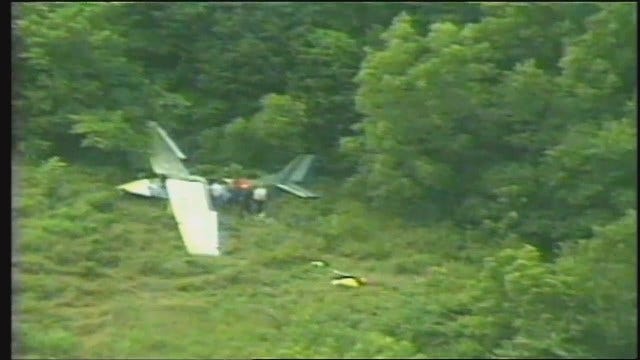NTSB Reclassifies Fatal Oklahoma Plane Crash 11 Years Later
The National Transportation Safety Board says a correction to how it classified the incident caused it to re-release its final report on a fatal Oklahoma plane crash more than 11 years after it happened.Thursday, December 11th 2014, 12:05 pm
The National Transportation Safety Board says a correction to how it classified the incident caused it to re-release its final report on a fatal Oklahoma plane crash more than 11 years after it happened.
The single-engine Cessna 182H crashed near Cushing Municipal Airport at 4:30 p.m. on June 21, 2003 while conducting a skydiving flight.
The crash killed the pilot and seriously two parachutists. In its Probable Cause Report on the incident, the NTSB blames the crash on "the pilot's failure to maintain airspeed which resulted in an inadvertent stall/spin."
The report says investigators could find no problems with the engine. The airplane had just had a 100-hour inspection a month before the crash.
Read the NTSB's Probable Cause Report on the crash.
An earlier report from the NTSB on the incident details how dramatic the sequence of events was that led up to the crash.
The NTSB identified the pilot as 37-year-old Steven Hill of Burbank, California who had 363 hours of total flight time. The injured skydivers were Glenn Miller of Noble and Shelly York of Norman.
According to the NTSB, the 1965 Cessna had been modified for skydiving. All the seats except for the pilot's had been removed and its wings and doors had been changed.
On the fatal flight, the pilot took off with five skydivers on board. When the airplane reached an altitude of about 4,000 feet, the first skydiver jumped out. The skydivers who were still on board told investigators that at that point the plane started to turn left and one of them heard the "stall buzzer" go off.
One of the skydivers said the pilot then told everyone to leave the airplane. Two of the skydivers told investigators the jumpers tried to help a skydiver who wasn't moving toward the door. One of the skydivers managed to jump out as the plane was spinning toward the ground and another was knocked out of the plane unconscious but his safety gear opened his chute automatically.
The other two skydivers were in the plane as it impacted the ground.
The NTSB spoke to a witness who called the pilot on the radio as soon as the witness noticed something was wrong. When he asked the pilot what the problem was, the pilot told him the plane was in a spin and he didn't know what to do. The witness told the NTSB he said, "Flaps and power," which meant he instructed the pilot to lower the flaps and move the throttle forward.
As the witness watched the airplane and the two skydivers who'd already jumped out, he saw another skydiver leave the plane and heard its engine speed up at about 800 feet of altitude. He said the plane seemed to slow its spin, but then went behind some trees and crashed.
A spokesman for the NTSB said the agency recently corrected a number of older accidents to indicate that they were “skydiving” operations rather than “air drop” operations and re-released the reports on them. He said the probable cause was determined much closer to the time of the accidents.
He said the agency did not notify the public that it was making the change.
More Like This
December 11th, 2014
April 15th, 2024
April 12th, 2024
March 14th, 2024
Top Headlines
April 23rd, 2024
April 23rd, 2024
April 23rd, 2024












